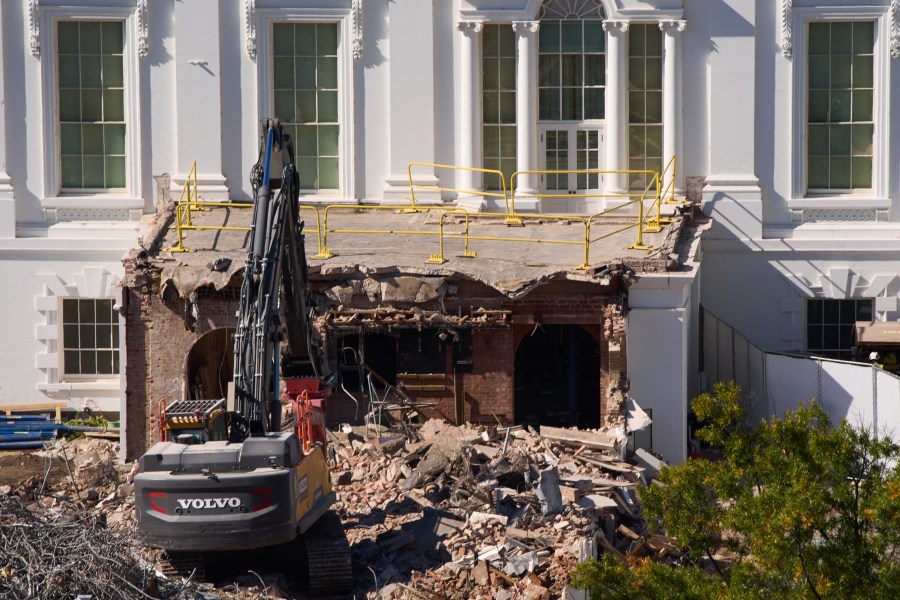White House sideswiped by ballroom demolition controversy

President Trump’s demolition of the East Wing to make way for a new ballroom this week built into a full-blown controversy for the White House.
Images of the East Wing abruptly being turned into a pile of rubble caused a visceral reaction for Trump critics, who saw it as a symbol of the ways the president has degraded the White House. Historians and preservation groups have expressed their dismay, and reporters have peppered administration officials with questions about changes in the project’s scope and cost.
As is typical in the Trump White House, the president’s team has gone on offense to try and shape the narrative and dismiss criticism as manufactured or hypocritical, appealing to their base in the process.
The administration has dismissed attacks on the project as “manufactured outrage.” Donald Trump Jr. has rebuffed critiques from members of the Clinton family by pointing out scandals during their time in the White House.
The Trump team also updated a page on the official White House website to include a timeline of “major events.” The timeline largely consists of significant construction projects, but Trump aides added in then-President Bill Clinton’s affair with Monica Lewinsky; the discovery of cocaine in the building during the Biden administration; and a 2023 Trans Day of Visibility celebration at which one attendee was topless.
“We’ve been keeping you apprised of this project. We’ve shown you the renderings. And if you look at the renderings, it’s very clear the East Wing was going to be modernized,” White House press secretary Karoline Leavitt told reporters Thursday.
“The president wants to do right by the people’s house. And so, that’s exactly what he’s doing,” she added. “It’s going to be … much more stable, strong, secure and more beautiful than ever once it’s complete.”
Republican strategist Susan Del Percio, who does not support Trump, acknowledged the story hasn’t been a good one for the White House.
But in a week where the government is still shut down and on the heels of massive “No Kings” protests, the White House might welcome another story.
“Yes, they were caught flat footed, but they don’t care,” Del Percio said.
The White House had announced at the end of July plans for a $200 million ballroom adjacent to the East Wing. Trump had for years sought to construct a similar space at the White House.
The project got fully underway this week when, to the surprise of many, construction crews began tearing down parts of the East Wing. Images of mangled metal and rock stunned observers who were not expecting part of the country’s most famous building to come crumbling down for Trump’s project.
The original White House announcement said the ballroom would be “substantially separated from the main building of the White House,” and Trump said the structure “won’t interfere with the current building.”
“It’ll be near it but not touching it. And pays total respect to the existing building, which I’m the biggest fan of,” Trump said on July 31.
Leavitt faced a barrage of questions during a Thursday briefing with reporters about the demolition of the East Wing. Journalists pressed her on whether the president had authority to tear down any building he wanted to in the nation’s capital; why the cost had increased by $100 million; how much of Trump’s own money was going toward the project; and why the public was not notified that the East Wing would be razed.
“With any construction project, there are changes over time as you assess what the project is going to look like, and we’ll continue to keep you apprised of all of those changes,” Leavitt said.
She argued the administration had been transparent, pointing to the July 31 announcement outlining the project and the models of the proposed ballroom Trump kept on display in the Oval Office.
Leavitt argued the East Wing demolition did not require outside approval from the National Capital Planning Commission, saying only new construction had to be reviewed by the panel before it is moved forward.
And she confirmed the price tag had risen to $300 million, while noting the cost would be covered by private donors, not taxpayers. Critics have argued the use of donations could open the door to private companies and individuals using ballroom donations to curry favor with the president.
The White House throughout the week deflected criticism from historians and Democrats about the scope of the project by pointing to past renovations and changes to the building.
White House officials pointed to the 1902 construction of the West Wing, the 1933 expansion of the West Wing and construction of the East Wing, the 1948 rehab of the building’s interior, the 1973 addition of a bowling alley in the basement, and the 2009 work that turned a tennis court into a basketball court.
Even some Democrats have acknowledged the utility of having a large event space at the White House. State dinners with foreign leaders are typically held under a temporary tent constructed on the South Lawn, and large indoor spaces in the White House can only hold a couple hundred people.
But it’s the way Trump has gone about tearing down the East Wing that has touched a nerve.
“I don’t think that there’s any question a ballroom is probably needed,” Michael LaRosa, who served as press secretary to then-first lady Jill Biden, said on “Sunrise on The Hill.”
“But I understand a lot of the sadness around the East Wing, because I feel it myself,” he added.
Amie Parnes contributed.